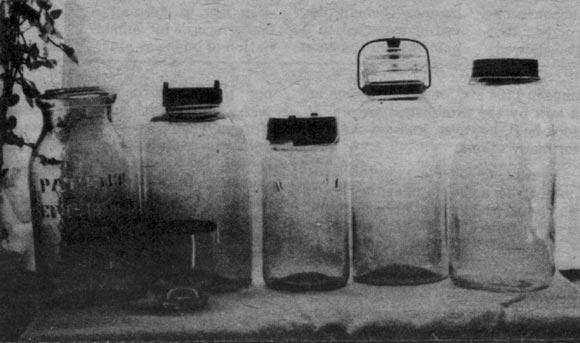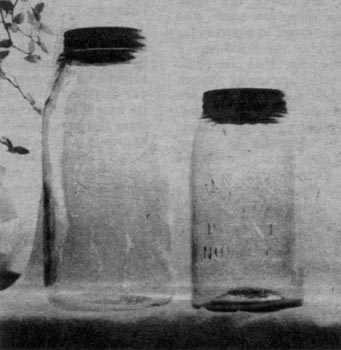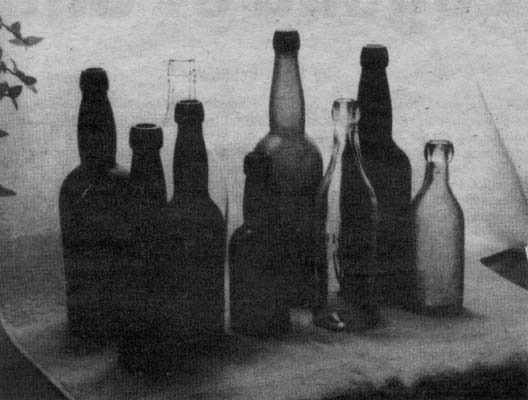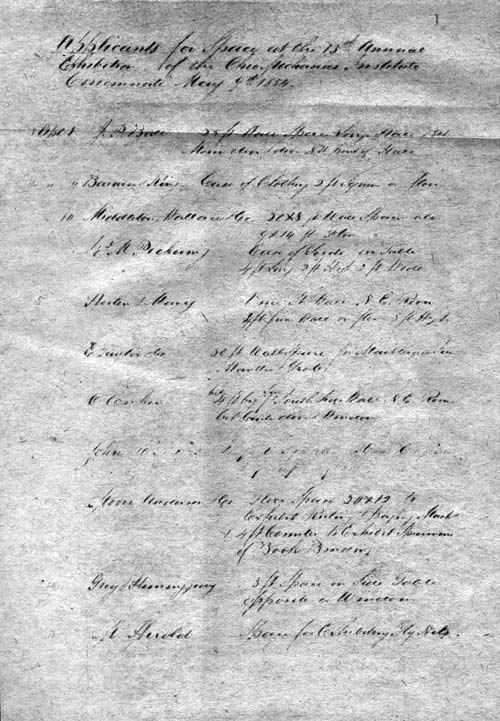[Newspaper]
Publication: The Antique Trader Weekly
Dubuque, IA, United States
p. 64, col. 1-4
Hemingray Glass 1848-1933
Some New Information on
The Covington, Kentucky Years
by Esther H.M. Power
Although Hemingray made glass for 85 years, little is in print about the company and even less about its operations in Covington, Kentucky. Fortunately, recent research provides some new information to help fill the void and clear up some of the longstanding uncertainties and errors about Hemingray's location, name changes, officers and products.
Because the company had overlapping and succeeding locations and because manufacturing was done in one place and a warehouse kept elsewhere, confusions have arisen. In brief, the general picture is this: the early Cincinnati years were followed by a period when the warehouse was located in Cincinnati but production took place across the river in Covington; then came years when all operations were in Covington, followed by years with offices in Covington and production in Muncie, Indiana; and finally, a period when all operations were moved to Muncie.
|
Hemingray Fruit Jars. From left to right: 1. an 1860 jar that had a wax seal and tin lid; 2. an 1863 jar with "ears" on the tin lid, sometimes called "the Cincinnati Jar"; 3. the oldest of the "Royals" dated 1863 on the lid, has metal collar: 4. an 1886 "Globe" jar with domed glass lid; and 5. a Mason's patent 1858 jar with the Hemingray monogram-H.G. Co. The small jelly glass is marked "H.G. Co." on the tin lid. From the collection of John Webster, Erlanger, Kentucky. Photo courtesy of Glenn Drummond, Cincinnati, Ohio.
The earliest years of Hemingray glass are still shrouded. At about age 27 Robert Hemingray left the Johnstown, Pennsylvania area and settled in Cincinnati — in 1847, where he started a modest glass house in 1848 with Ralph Gray. This partnership, called Gray and Hemingray, is first listed in the city directory as "glass manufacturers, Hammond St." in Cincinnati. Whether either had any previous glass experience is still a matter of speculation.
By 1853 the partners had moved across the Ohio River to Covington and had opened a glass house at 2nd and Madison Street. It is unlikely that they made glass in Cincinnati after the move because the river is wide at that point and only a ferry connected the two cities. The Covington plant location close to the river permitted barges to load and unload almost at their door. Hemingray kept the "ware room" in Cincinnati open until 1882 which explains the listing in the Cincinnati directory until then.
|
A closer look at the Mason's patent jar. The one on the left shows the Hemingray monogram. When turned around, it would show the Mason's Patent 1858 side which is seen on the smaller jar at the right. From the collection of John Webster, Erlanger, Kentucky. Photo courtesy of Glenn Drummond. Cincinnati, Ohio.
The first change in name came in 1857 when it became Gray, Hemingray and Bros., with Anthony Gray and Samuel Hemingray joining the partnership. In 1864 Gray retired from the glass business and Robert and Samuel Hemingray incorporated as Hemingray Bros and Co. For one year only, 1868-69, the company was listed as R. Hemingray & Co. The final change name in 1870 when the company became Hemingray Glass Company, a name that continued until the company was acquired by Owens-Illinois in 1933.
After consolidating all operations in Kentucky, the company suffered from two devastating floods. The river, whose flood stage is 52 feet, reached 66.3 in February, 1883 and 71.1 in February, 1884. Because of the extensive damage to the plant and because of the discovery of natural gas in Indiana, Robert Hemingray looked to Muncie for a new plant site. The new fuel reduced production costs and eliminated dependence on the river. The Muncie plant was finished about 1890 and the Covington plant phased out. The exact closing date is still being debated with contradictory evidence supporting both an early and late closing. Only documentary evidence will settle the question.
As with the case of Cincinnati, Hemingray kept the warehouse and offices in Covington after the plant closed. The usual explanation given for the move to Indiana is that the company was flooded out in 1919. The date is more accurate than the reason. Unfortunately for those who perpetuate this myth, there is no record for a flood in 1919. It was the two earlier floods that led to the move.
The Hemingray Glass Company was always run as a family enterprise. Robert, founder and first president, had three sons — Ralph, Robert, Jr., and Daniel, all of whom were active in the company. Since at least —1880 Ralph had been vice president of the firm, having served earlier as plant superintendent of the "flint works" in Covington for a number of years. By 1895 Ralph had moved to Muncie and Robert had joined him there as plant superintendent, leaving Daniel in Covington where he's listed as traveling salesman.
When the elder Hemingray died in 1898, Ralph moved up to the presidency and Robert. Jr. to the vice presidency, both living in Muncie. Daniel (as Secretary-Treasurer) stayed in Covington and became a member of a number of Cincinnati's prestigious social and business clubs.
With the untimely death in 1901 of Robert, Jr., Bradford Shinkle moved into the vice presidency, a post he held until his death. Although the name sounds new, Bradford was Daniel and Ralph's brother-in-law who had married not one but two of their sisters, Anna and Meta.
Bradford came from a prominent Covington family and sat on a number of boards, including the position of treasurer for Shinkle, Wilson, and Kreis Co., importers of coffee and jobbers of coffee, sugar, molasses and rice. Many of these positions he "inherited" from his father just as his son "inherited" the vice presidency of Hemingray Glass Co. when Bradford died. The Shinkle contribution to the company appears to be in management rather than any technical help in glass manufacturing.
The final change in the company's presidency came in 1920 with Ralph's death. Since he had no sons, the responsibility for the family enterprise passed to his son-in-law, Philip McAbee. Thus, the Hemingray Glass Co. had only three presidents; Robert, his son Ralph, and Ralph's son-in-law Philip.
Hemingray advertising during the Covington years provides one of the most reliable sources of information on what was manufactured there. As early as 1850 Gray and Hemingray advertised flint glassware, apothecary's furniture, chemical apparatus, perfumer's ware and telegraph glasses.
|
In this group of Hemingray bottles 7 are beers in assorted sizes. The small bottle on the right is a mineral water bottle, and the tall clear one second from the left is a whiskey. It is one of the few known bottles with the early G&H mark. From the collection of John Webster, Erlanger, Kentucky. Photo courtesy of Glenn Drummond, Cincinnati, Ohio.
With the completion of telegraph lines connecting Cincinnati with Pittsburgh and Louisville in 1847 and the coming of the railroad to Cincinnati in 1848, a growing market developed for telegraph insulators. Both Robert and Ralph worked to improve insulators and each received a patent. Robert's was for a process of forming the glass, and these have the December 19, 1871 patent date on them. Ralph, with James C. Gill of Muncie, received the drip point patent dated May 2, 1893. In some instances Hemingray made insulators for telegraph companies and embossed them with that company's name rather than their own.
Charles Cist writing in 1851 notes that "Gray and Hemingray make tumblers, decanters, packing bottles, lamp glasses, apothecary shop furniture, and generally, most articles manufactured in Pittsburgh. A greater variety of perfumery glass is manufactured in these works than at any in Pittsburgh." Writing in 1859, Cist claims that Gray, Hemingray and Bros. "excels any there (Pittsburgh) in the variety of articles which it manufactures." He adds glass milk pans and atmospheric fruit jars to the list. Plus an "etc."
One of those "etc." items is paperweights which go unmentioned by him and in the ads. Gray and Hemingray exhibited paperweights at the 13th Annual Mechanics' Fair in Cincinnati in 1854. The report of the Fair stales: "The paperweights, exhibited by Mssrs. Gray and Hemingray, are a very fine article, and they deserve much credit for the progress they have made in that difficult department of their business." They received a First Class Diploma for their entry.
In addition to paperweights, they entered "cut, pressed and ornamental glass", totaling 40 pieces. In the manuscript application for space shown in the accompanying photograph, this entry appears, "a three foot space on side table opposite a window", no doubt to show the glass off in the best light.
|
The 10th entry on this page shows Gray and Hemingray's application for space to display their glassware at the Ohio Mechanics Institute Fair in 1854. This copy is from the manuscript materials in the Archival Collections of the University of Cincinnati.
Gradually, there is a shift away from flint glass-making and the emphasis centers on green and black glassware. An 1878 ad shows this trend, itemizing "Lamps, Lanterns (railroad and steamship), Fruit Jars, Shop Furniture, Demijohns, Brandies, Flasks, Hock Wines, Beer Bottles, Mineral Water Bottles, Candy Jars, Fish Globes etc." A picture of an oil can with the legend "Sole Manufacturers of the Elgin Oil Can" illustrates the ad.
Two of these categories deserve special mention — fruit jars and beer bottles. How soon Heminray got into fruit jar making is yet unknown, but it must have been early. Some kind of fruit jar was available in Cincinnati in 1848 because a newspaper ad by an agent for an unnamed manufacturer lists "pickle and preserve jars, wide mouth and tie over." Other early Cincinnati fruit jars were those exhibited by James Spratt at the Fair in 1854 and referred to as "self-sealing tomato and fruit cans." No doubt Hemingray saw these before receiving his own first patent for fruit jars September 18, 1860.
Two other early patent dates for Hemingray fruit jars are June 9, 1863 and June 27, 1865. Later Robert received the Globe fruit jar patent (May 25, 1886). In addition, there are three known "Royal" jars attributable to Hemingray. With new information still coming to light, it now appears that Hemingray made at least 7 or 8 different fruit jars.
Most beer bottle collectors are interested in the embossing on the side of the bottle indicating the brewery, but Hemingray collectors look for the mark of the glass manufacturer. Located in the Cincinnati-Covington-Newport brewing center, Hemingray had a good market for his amber and aqua bottles in the 1880s and 1890s. Since at the turn of the century the Charles Boldt Co. wad the leading manufacturer of beer bottles in the area and was the only local firm licensed by Owens Bottle Machine Co., it seems likely that either Hemingray discontinued making beer bottles in Covington or had left for Muncie.
By the time Hemingray closed its Cincinnati office in 1882, its advertised product list had shrunk to bottles, lamps, fruit jars and kerosene oil cans. By the time Hemingray left Covington for good in 1919, few remembered the earlier days when glass making was a folk art and the product of hand and mouth.
The most common marks found on Hemingray glass are "H". "HG Co." and "Hemingray." Some insulators and fruit jars are marked only with Hemingray patent dates. The clear whiskey pictured with the bottles is one of the few known pieces with a "G & H" (Gray and Hemingray] mark.
In the spring of 1975 a Covington news story reported that a bank officer had discovered a leather pouch of silver belonging to Daniel Hemingray in the vault. Some of us knew who Daniel was and wished that instead of silver a cache of flasks, paperweights, bottles and threadless insulators had been found.



